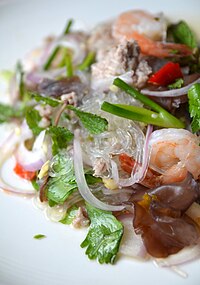
Photo from wikipedia
BACKGROUND The potential health promoting effects of polyphenols depend considerably on their bioaccessibility, which is affected by the presence of other nutrients in the diet including lipids. In the present… Click to show full abstract
BACKGROUND The potential health promoting effects of polyphenols depend considerably on their bioaccessibility, which is affected by the presence of other nutrients in the diet including lipids. In the present study, several salad dressing formulations were prepared using industrial broccoli by-product powder (BBP), lemon juice (LJ) and three different sources of oils including olive oil, hazelnut oil and sunflower oil, to both valorize polyphenol-rich industrial discards and also to investigate polyphenol bioaccessibility. The changes in the bioaccessibility of polyphenols from BBP and LJ were determined using the standardized in vitro digestion model. RESULTS Four groups of polyphenols including hydroxycinnamic acids, flavonols, flavones and flavonones were detected in BBP and LJ. The bioaccessibility of hydroxycinnamic acids and flavonols from BBP increased significantly in the presence of LJ and oils (0.3-5.8 fold), while there was no significant difference between formulations containing different oil types. On the other hand, the bioaccessibility of phenolic acids from LJ did not change notably after co-ingestion with BBP and oils, whereas flavonoids, including vicenin-2 and hesperidin, were found to be significantly more bioaccessible when LJ was co-ingested with BBP and oils (0.8-1.4 fold) (p<0.05). CONCLUSION Overall, the current study highlighted that the bioaccessibility of polyphenols from BBP and LJ was modulated in the presence of an oil matrix. This article is protected by copyright. All rights reserved.
Journal Title: Journal of the science of food and agriculture
Year Published: 2022
Link to full text (if available)
Share on Social Media: Sign Up to like & get
recommendations!